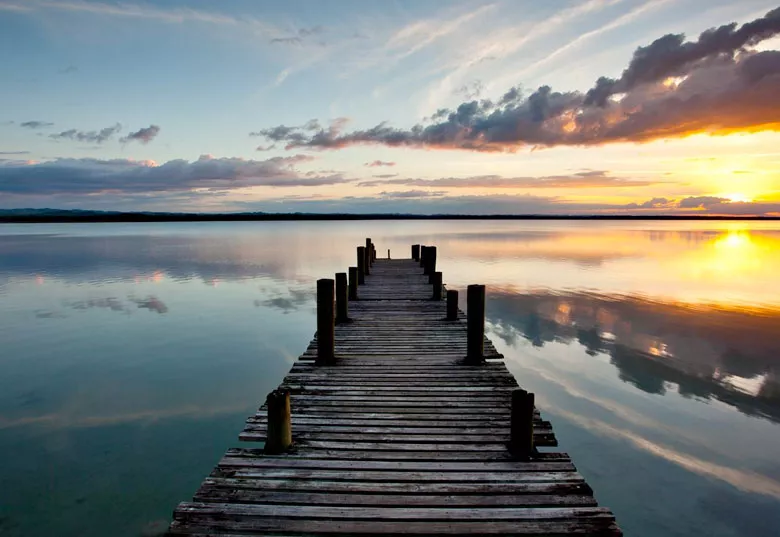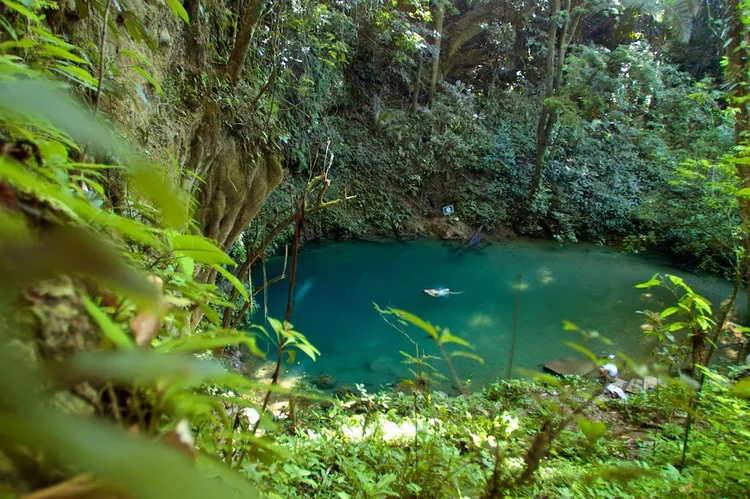Summary
- Five Blues Lake National Park (Belize)
- Atitlan Lake (Guatemala)
- Peten Itza Lake (Guatemala)
- Izabal Lake (Guatemala)
- Lake Arenal (Costa Rica)
- Cano Negro (Costa Rica)
- Yojoa Lake (Honduras)
- Lagoon of Guaimoreto (Honduras)
- Coatepeque Lake (El Salvador)
- Lake Ilopango (El Salvador)
- Lake Guija (El Salvador)
- Lake Nicaragua (Nicaragua)
- Gatun Lake (Panama)
- Bayano Lake (Panama)
Because of its tropical climate, rugged terrain, and large forests, Central America is rich with waterways, lakes, and lagoons. Places with water afford some of the most amazing views in nature. You can just revel in the view and take lots of photos or get in on the action and go kayaking, snorkeling, swimming, fishing, or boating. Check out this list for some of the best lakes to visit in Central America.
Five Blues Lake National Park (Belize)
Five Blues Lake National Park is centered on the gorgeous and intensely blue lake of its name. The various shades of blue in the water are a result of light filtered through the rain forest. In addition to regular lake activities such as swimming and boat tours, you can explore the limestone hills and caves surrounding the park. Moreover, the park is home to over 200 bird species and about 20 mammal species, making it a fantastic spot for wildlife enthusiasts. Fortunately, this park remains relatively uncrowded, allowing for a peaceful experience.
Atitlan Lake (Guatemala)

Atitlan Lake, often touted as the most beautiful lake in Guatemala, originated centuries ago when a massive volcano collapsed. It is now surrounded by three dormant volcanoes and 12 picturesque villages. Popular activities in this stunning locale include boat rides, jet skiing, diving, and swimming. Additionally, engaging in volcano climbing, enjoying nightlife in Panajachel, and visiting Mayan museums full of ancient artifacts will round out your experience at Lake Atitlan.
Peten Itza Lake (Guatemala)

Peten Itza Lake, located in the northern region of Guatemala, is the country’s second largest lake. It attracts travelers looking to explore archaeological sites like Tikal and El Mirador; surrounding the lake, there are at least 27 sites to discover. The main city in the area is situated on a small island at the southern end of the lake, where accommodations offer stunning views, especially during sunset. Peten Itza serves as a vital water source and habitat for around 100 indigenous species, including crocodiles, jaguars, pumas, deer, parrots, toucans, and macaws.
Izabal Lake (Guatemala)

As the largest lake in Guatemala, Izabal Lake is fed by the country’s biggest river. The main attraction is the opportunity to embark on a boat tour, exploring the lake and traveling along the Rio Dulce toward the Caribbean. This area is renowned for its mangroves and diverse wildlife and is home to various species, including manatees, jaguars, spider monkeys, and howler monkeys, as well as numerous bird species.
The well-preserved colonial fortress, Castillo de San Felipe de Lara, can be reached by boat from the lake. Historically, Rio Dulce served as one of Central America’s principal ports during the colonial period, with the fortress constructed to safeguard the lake from pirate incursions. Sunken ships can also be found in the vicinity.
Lake Arenal (Costa Rica)

Lake Arenal is Costa Rica’s largest man-made lake, located at the base of the active Arenal volcano. This location provides excellent opportunities for fishing for rainbow bass (guapote) and world-class windsurfing, particularly in March. In addition to water activities, visitors can experience canopy tours and hike up the volcano for exceptional views alongside wildlife spotting.
Cano Negro (Costa Rica)

Cano Negro is a shallow lake that appears primarily during the rainy season. As the rains cease in December, the water begins to recede rapidly, disappearing by February. It is situated in the northern region of Costa Rica and serves as a popular destination for bird watchers in the latter half of the year, when flocks of ducks, herons, and other waterfowl flock to the area. Recognized as a wetland of international significance under the RAMSAR convention, Cano Negro’s importance for local and global wildlife cannot be understated. The best access is via a boat ride on the Frio River.
Yojoa Lake (Honduras)

Yojoa Lake is the largest lake in Honduras, formed within a depression caused by the surrounding volcanoes, situated in a volcanic field with craters. Travelers can drive along one side of the lake while journeying from Tegucigalpa to San Pedro Sula. The lake serves as a rest area with local restaurants offering fresh fish and stunning views of both the water and nearby mountains. For those seeking a more immersive experience, activities such as fishing, bird watching (over 400 species), and visiting local plantations are readily available.
Lagoon of Guaimoreto (Honduras)

The Lagoon of Guaimoreto, located in Honduras, is a small reservoir of fresh water that supports the region’s biodiverse flora and fauna. Strategically separated from the Caribbean Sea by a thin land barrier, visitors can take boat rides through its mangroves and wetlands to admire the local wildlife. Moreover, kayaking or canoeing through the waterways or participating in traditional fishing expeditions with locals can enhance your visit.
Coatepeque Lake (El Salvador)

Coatepeque Lake, known as a crater lake, has formed in a volcanic caldera. This picturesque lake features naturally heated hot springs as well as an island that houses a Mayan site. Here, visitors can enjoy boat rides, jet skiing, swimming, or kayaking. Additionally, nearby restaurants serve delicious stuffed tortillas and fresh seafood to recharge after a day of activities.
Lake Ilopango (El Salvador)

Lake Ilopango, also a crater lake, forms part of a volcanic complex and is the second largest lake in El Salvador. Among its unique features are islands filled with various bird species, accessible via boat tours. Additionally, there are underwater land formations, referred to by locals as sunken mountains, which attract scuba divers seeking adventure.
Lake Guija (El Salvador)

Lake Guija straddles the border of Guatemala and El Salvador and has a volcanic origin, surrounded by three volcanoes. The El Salvadoran shore features several small islands where archaeologists have unearthed pre-Columbian artifacts and ceramics. Recognized as a site of cultural importance, Lake Guija was added to the UNESCO World Heritage Tentative List in September 1992. Although relatively uncrowded, developments in hotels and restaurants are beginning to emerge around the lake.
Lake Nicaragua (Nicaragua)

Lake Nicaragua, or Lago de Nicaragua, is the largest lake in Central America. Its history includes pirate incursions against the lakeside city of Granada. Additionally, it is home to Ometepe Island, featuring two majestic volcanoes. Near Granada, travelers can discover a group of islets teeming with bird species, adding to the area’s natural beauty. Opting for a boat tour is an enjoyable way to explore this enchanting lake.
Gatun Lake (Panama)

Gatun Lake is a large, man-made lake created as a result of the construction of the Panama Canal and the Gatun Dam. When constructed in 1913, it was the largest man-made lake in the world. Exploring Gatun Lake via cruises of the Panama Canal is an excellent way to appreciate its size and beauty. Smaller boat tours allow you to observe the wildlife closely and see parts of the lake that larger cruises do not reach.
Bayano Lake (Panama)

Bayano Lake, located in eastern Panama, is the second largest lake in the country, formed in 1976 in conjunction with dam construction. A key feature of this lake is a complex of three caves located along its shores. During the rainy season, visitors can embark on boat tours that take them deep into these caves, where they may even encounter the resident bats. Bird watching, kayaking, and fishing are typical activities in the Bayano Lake area.





